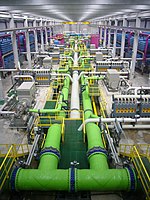
Photo from wikipedia
The freezing–thawing method had been reported to be the best phycobiliprotein extraction technique. However, optimum parameters of this extraction method for Arthrospira sp. (one of the major phycobiliprotein sources) still… Click to show full abstract
The freezing–thawing method had been reported to be the best phycobiliprotein extraction technique. However, optimum parameters of this extraction method for Arthrospira sp. (one of the major phycobiliprotein sources) still remained unclear. Hence, this study aimed to optimize the freezing–thawing parameters of phycobiliprotein extraction in Arthrospira sp. (UPMC-A0087). The optimization of the freezing–thawing method was conducted using different solvents, biomass/solvent ratios, temperatures, time intervals and freezing–thawing cycles. The extracted phycobiliproteins were quantified using a spectrophotometric assay. Double distilled water (pH 7) with a 0.50% w/v biomass/solvent ratio was the most efficient solvent in extracting high concentrations and purity of phycobiliproteins from Arthrospira sp. In addition, the combination of freezing at −80 °C (2 h) and thawing at 25 °C (24 h) appeared to be the optimum temperature and extraction time to obtain the highest amount of phycobiliproteins. A minimum of one cycle of freezing and thawing was sufficient for extracting high concentrations of phycobiliproteins. The findings from this study could reduce the cost and labor needed for extracting high quality phycobiliproteins. It also allowed the harvesting of large amounts of valuable phycobiliproteins.
Journal Title: Molecules
Year Published: 2020
Link to full text (if available)
Share on Social Media: Sign Up to like & get
recommendations!